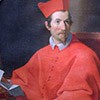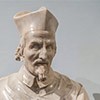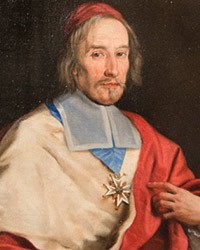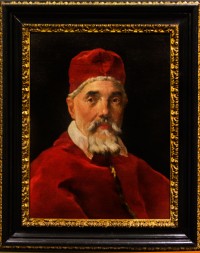Francesco Barberini (1597–1679) – papal nepot, admirer of books and art, defender of Galileo

Bust of Cardinal Francesco Barberini, Lorenzo Ottoni, Galleria Nazionale d'Arte Antica, Palazzo Barberini

Portrait of Cardinal Francesco Barberini, Ottavio Leoni, pic. Wikipedia

Palazzo Barberini, driveway to the main enterance of the palace

Portrait of Cardinal Francesco Barberini, Andrea Sacchi, Wallraf-Museum, pic. Wikipedia

Tapestries from the Barberini Manufacture established by Francesco Barberini, Musei Vaticani

Foundation of Francesco Barberini – Church of San Carlo alle Quattro Fontane (design – Francesco Borromini)

Church of Santi Luca e Martina – foundation of Cardinal Francesco Barberini
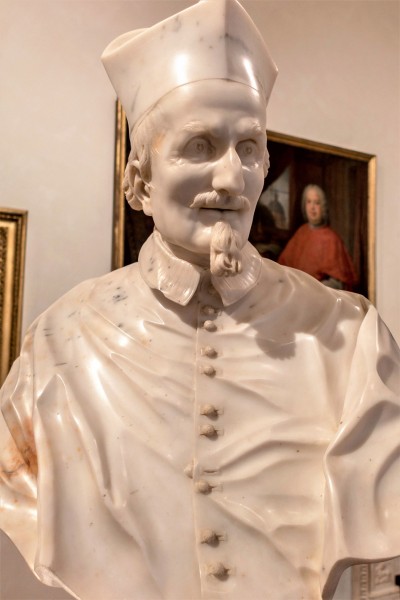
Bust of Cardinal Francesco Barberini, Lorenzo Ottoni, approx. 1680 r., Museo di Roma, Palazzo Braschi

Bust of Francesco Barberini, Lorenzo Ottoni, Galleria Nazionale d'Arte Antica, Palazzo Barberini

Tombstone monument of Cardinal Francesco Barberini, vestibule of the sacristy of Basilica of San Pietro in Vaticano
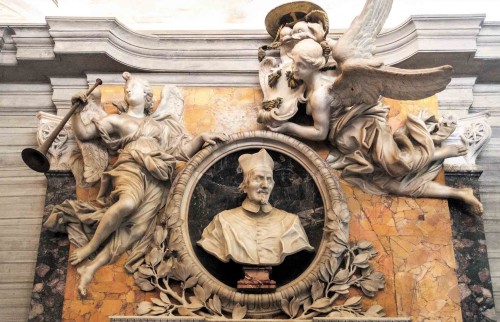
Tombstone monument of Cardinal Francesco Barberini, fragment, vestibule of the sacristy of the Basilica of San Pietro in Vaticano

Church of Santi Luca e Martina, plaque commemorating Pope Urban VIII and the reconstruction of the church by Francesco Barberini

Bust of Francesco Barberini, Lorenzo Ottoni, Museo di Roma, Palazzo Braschi
Francesco was the first cardinal nepot elevated to this dignity by pope Urban VIII, a few months after his enthronement in 1623. Along with it he was granted the responsible function of Superintendent General of the Ecclesiastical State as well as other, equally profitable benefits. Yet he was probably more pleased with the appointment to the function of Librarian of the Holy Roman Church, since he was known for his passion for reading and collecting books. By his contemporaries he was considered a polite, honest, religious person, albeit impulsive.
Francesco was the first cardinal nepot elevated to this dignity by pope Urban VIII, a few months after his enthronement in 1623. Along with it he was granted the responsible function of Superintendent General of the Ecclesiastical State as well as other, equally profitable benefits. Yet he was probably more pleased with the appointment to the function of Librarian of the Holy Roman Church, since he was known for his passion for reading and collecting books. By his contemporaries he was considered a polite, honest, religious person, albeit impulsive.
Nine years later Cardinal Francesco, was appointed to the position of vice-chancellor and became the most important of the papal ministers, and from the beginning of the 1640s, when his uncle’s illness worsened, the driving force behind the politics of the State of the Church. He was an example of a nepot, who tried to use the authority possessed in the best way possible for the good of his family and the glory of Urban VIII, also in the case of artistic patronage. He showed it in 1625, when on pope’s orders, he bought a palace on Quirinal Hill and employed two of the greatest architects of the time to expand it – Carlo Maderno, followed by Gian Lorenzo Bernini. The result was a family residence of truly royal proportions – a pearl in the tiara of the Barberini family – Palazzo Barberini.
When in 1628, the younger brother of Francesco – Antonio Barberini was also elevated to the role of cardinal nepot and was to sit at the College of Cardinals, the former did not hide his displeasure. For Romans it was no secret, that the brothers not only dislike but also compete with each other, which from the point of view of artistic patronage was even advantageous. They competed not only for the pope’s attention and appanages but also for better theatrical performances, better book collections, a better painting, fresco and acquaintances with artists and erudites. The proof of this is the marvelous collection of manuscripts, paintings, tapestries, as well as decorations of the rooms in Palazzo Barberini. Francesco’s apartments were located in the southern wing of the building, Antonio’s in the northern. Their artistic tastes can still today be seen in the palace interior, in its ceilings and walls richly decorated with frescos. A favorite of cardinal Francesco was the painter Francesco Romanelli. Later activities in the field of artistic patronage were also taken up by the third Barberini brother – Taddeo, whose favorite was in turn Andrea Camassei. Such policy, which inspired other cardinals who sympathized with the Barberinis (Giulio Sacchetti, Bernardino Spada), had as its goal the creation of a new era in art and at the same time a golden age of peace and prosperity, blooming under the patronage of Urban VIII and his family. The most vivid sign of this new era was the painting created in the Salone Grande of Palazzo Barberini by Pietro da Cortona, The Triumph of Divine Providence. This painter became a favorite of Francesco Barberini, but other painters benefited from his protection as well, such as Andrea Sacchi, but most of all the French: Nicolas Poussin, Simon Vouet, or Valentin de Boulogne. The cardinal did not hide his fascination with French culture, with vigor he collected French books, while the gift of the king of France – tapestries completed according to the design of Paul Rubens became an impulse to create the Barberini Tapestry works in Rome, which were responsible for the creation of a series of unique tapestries embellishing the rooms of Palazzo Barberini and the Vatican Apostolic Palace. After Francesco’s death the works were shut down and production was halted.

Thanks to the individual commitment of the cardinal, we also have the Church San Carlo alle Quattro Fontane (1640), a small church of Trinitarians near Palazzo Barberini, of which the construction was entrusted to the ambitious architect Francesco Borromini, who created a true pearl of Baroque art.
As a member of the Roman Inquisition Francesco participated in the trial of Galileo, with whom Pope Urban VIII, was previously on rather friendly terms. It must be admitted that this trial was difficult and uncomfortable for the Barberinis. When the sentence was pronounced in 1633, Francesco as one of three judges refused to sign the act condemning Galileo and helped to alleviate the punishment given to him. In the end the advocate of the theory of heliocentricity was not sentenced to being locked away in a monastery, but a rather to comfortable house arrest.
When in 1644, Urban VIII died, the mood in Rome was not supportive of the Barberinis. The Romans were irritated by the family coat of arms visible everywhere, the wealth accumulated through two decades, nonchalance, excessiveness, and the greed of the younger Barberini brothers – Antonio and Taddeo. Riots erupted in the city. Oblivious to all this, the cardinals Francesco and Antonio turned up at the conclave, sure of their clout and the ability to force unto others the candidate dictated to them by France, with which they have kept close, also financial relations, since the beginning of the pontificate of Urban VIII. The candidate of the Barberinis was Giulio Sacchetti. When it turned out that they cannot count on his victory, while the Spanish proposed lucrative conditions if they would support their candidate, the brothers changed their mind. Gian Battista, Pamphilj (Innocent X), who was their former protégée, albeit somewhat ignored, became the new Bishop of Rome. The pope, examining the treasury dented by the nepots, accused the Barberini brothers of embezzlement, confiscated their estates and took away their church offices. When the vision of prison became a dangerously close reality, all three of them fled Rome and went to the French court, where despite betraying French interests, they found protection under the wings of the omnipotent cardinal Jules Mazarin, a previous protégée of the Barberinis.

In 1648 Francesco was granted papal pardon, returned to Rome and once again moved into Palazzo Barberini at via Quattro Fontane. Once again he became an important figure in the College of Cardinals, however less so in the artistic fields. However, he did not forego expanding his library and continued to host intellectuals and artists who visited the Eternal City, for example Diego Velázquez, put on theatrical performances which attracted throngs of aristocrats and clergymen to his palace. He continued to support painters who were earlier so devoted to him, commissioned new paintings, including from his previous favorite Pietro da Catona, an immense painting of Xenophon’s sacrifice to Diana, which was an allusion to the return of the Barberinis from emigration and was an homage to the sister-in-law of Innocent X, Olimpia Maidalchini, who significantly contributed to said return. The cardinal also entrusted the artist with a thorough reconstruction of the Church of Santi Luca e Martina – a temple under the patronage of the Academy of St. Lucas (Accademia di San Luca), which had previously enjoyed the protectorate of both he and his uncle the pope.
As vice-Dean and Dean of the College of Cardinals, Francesco Barberini contributed to the election of four consecutive popes. He died at the age of 82 and his modest tombstone is found in the vestibule of the sacristy of St. Peter’s Basilica.

















